Here are the main results on gravitational waves/B-modes from the CMB, as reported by the BICEP2 experiment. For background see my previous post. All of the BICEP2 results and plots are here.
First, the best fit to r, the ratio of gravitational waves to density perturbations:
Rumors were right, and r = 0.2 is the best fit (with errors plus .07, minus .05). Here is the power spectrum (amplitude as a function of angular scale on the sky):
And here we have the contours in r/nS space, analogous to the Planck constraints we showed yesterday. Note that this plot crucially allows for “running” of the spectrum of density perturbations signal — the size of the fluctuations changes in a more complicated way than as a power law in wavelength. If running weren’t included, the different constraints would seem more incompatible.
Comparison with other limits (BICEP2 results are black dots at bottom):
Finally, here is a map of the actual B-mode part of the signal:
Overall, an amazing result (if it holds up!). It implies that the energy scale of inflation is about 2×1016 GeV — pretty close to the Planck scale (2×1018 GeV). An unprecedented view of the earliest moments in the history of the universe.
[From earlier.] Here is an email from BICEP2 PI John Kovac:
Dear friends and colleagues,
We invite you to join us tomorrow (Monday, 17 March) for a special webcast presenting the first results from the BICEP2 CMB telescope. The webcast will begin with a presentation for scientists 10:45-11:30 EDT, followed by a news conference 12:00-1:00 EDT.
You can join the webcast from the link at http://www.cfa.harvard.edu/news/news_conferences.html.
Papers and data products will be available at 10:45 EDT from http://bicepkeck.org.
We apologize for any duplicate copies of this notice, and would be grateful if you would help share this beyond our limited lists to any colleagues who may be interested within our CMB and broader science communities.
thank you,
John Kovac, Clem Pryke, Jamie Bock, Chao-Lin Kuoon behalf of
The BICEP2 Collaboration
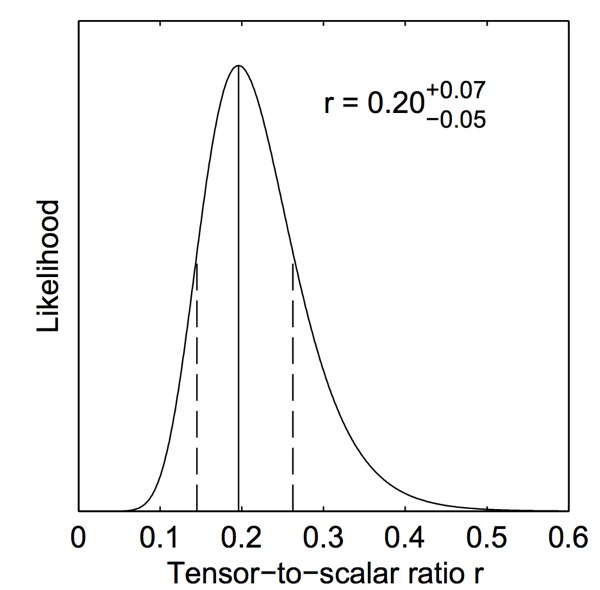
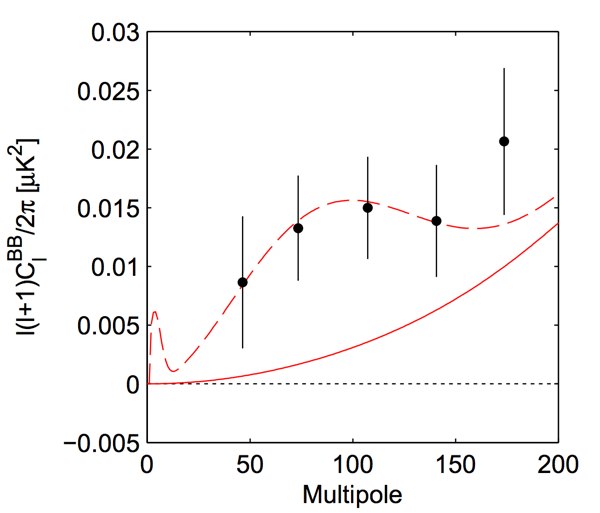
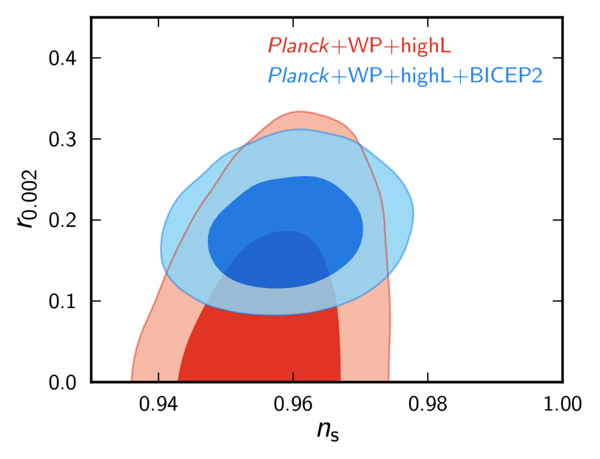
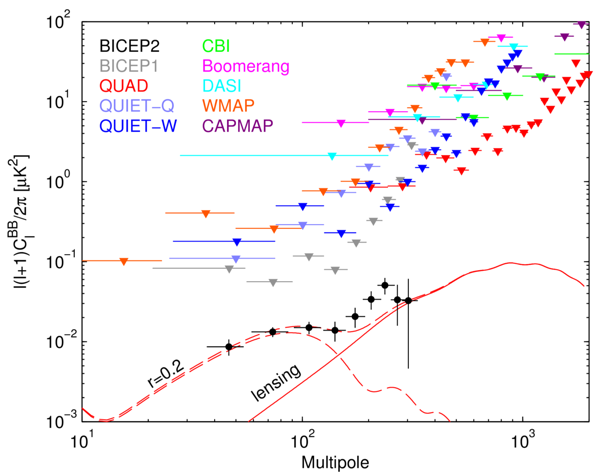
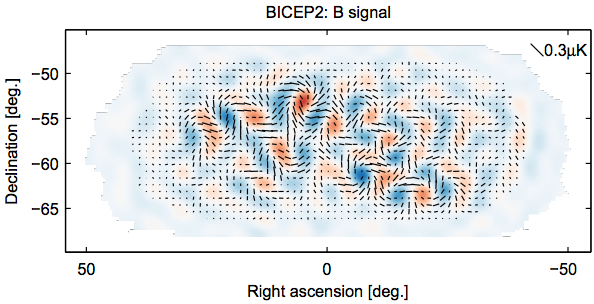
This is probably a stupid question, but if an infinite number if photons were constrained in an infinitely small space, what would happen if that restrain was removed?
Hi Sean,
I am not a physicist so would you please explain how an error of >= 25% in r is a remarkable value, and how the measured energy scale of inflation, which is 1/100th the Planck scale value, is “pretty close” to it?
Does anyone know where I could find the data for the E/B maps (Figure 3). I Couldn’t find it on the project website.
Pingback: BICEP2 und die ersten Sekundenbruchteile nach dem Urknall › RELATIV EINFACH › SciLogs - Wissenschaftsblogs
@Grepo
The scale is pretty close to the Planck scale if you view it on an exponential scale and compare to the stuff we see at the LHC, which is 12 orders of magnitude lower.
I’m not sure the 25% error in itself has been called remarkable; what is new is that there’s a measurement of a value where there were only upper bounds before. Some not-so-realistic values were previously ruled out but the value of r could have been arbitrarily low. This is the first time we have a sharp enough picture to see that there’s something there. It’s still quite fuzzy though.
Pingback: The Most Exciting Sentence I’ve Read This Decade… » Balloon Juice
Pingback: BICEP2 – Uma coletânea de links « Um Passeio Aleatório
Thank you for the post. Do you know what the frequency of the gravitational wave that BICEP detected its signiture is ? 10^-18 Hz ? I looked at their paper and couldn’t find out. I need this for my research. I will quote you if you let me know about it 🙂
Thank you
@Steve: I took a look at Ethan Seigel’s post, and I think he’s looking at the wrong part of the paper.
According to the actual BICEP2 paper, http://arxiv.org/pdf/1403.3985v1.pdf, the 2.7 sigma figure refers to “detection of lensing in the BICEP2 BB autospectrum.” This is not the important result of the paper.
BICEP2 was specifically not looking for evidence of gravitational lensing. They were looking for evidence of primordial gravitational waves leaving a specific imprint on the CMB polarization. Thus, the relevant and important result in the paper is summed up by the following quote:
“This excess represents a 5.2 sigma excursion from the base lensed-LambdaCDM model.”
That means there is a large signal above and beyond what is expected due to lensing, which represents rather strong evidence (5 sigma evidence, which in the particle physics community is enough to label something a “detection”) that something else interesting is going on. The most likely explanation is tensor perturbations from gravitational waves created at around the time of the big bang itself.
I was about to post something very similar to what Tristan just posted, but I think he is right that the 2.7-sigma significance level applies specifically to BICEP2’s detection of the foreground lensing signal. If you wanted to be a real stickler about statistical details, you could say that the BICEP2 detection from 40 < ell < 200 is a 5.2-sigma detection of *something* other than lensing, with the reported r = 0.20 +0.07/-0.05 representing a 4-sigma detection of a non-zero tensor-to-scalar ratio. That's still a considerably more robust result than is claimed in Ethan's post.
I forgot to mention, in the interests of full disclosure, I was a postdoc in Brian Keating’s lab from 2004-11, but I’ve been out of the observational cosmology field for three years now. I think my interpretation above is about as conservative as you can fairly be based on the reported results, though.
JollyJoker,
Thanks for the explanation, but I am too ignorant on the subject to understand why a 2 order of magnitude difference is considered “pretty close” even on an exponential scale. It’s better than a 12 order of magnitude difference, but we obviously have different ideas on what “pretty close” means. In all my school and professional experience, a 20 dB difference is laughing-stock territory.
So should Alan Guth and Andrei Linde get a Nobel now?
Do the measurements actually agree with the inflation model? If I look at the plots of the power spectrum I would think that the data does not agree with the model. Right when the model is supposed to turn down the data goes up.
How strong is this evidence? Should we be sceptical until confirmed with other instruments? The data seem to be outside the bounds set by plank data you previously posted but agree with a “running” signal? What are the implications of a large r?
Ray,
I get the impression that the physics community has sorta moved beyond the Nobel. I’m pretty sure every physicist would agree that the most notable achievement before BICEP2 in recent history was the CERN team’s discovery of the Higgs, and I’m also pretty sure that that same set of physicists would give credit as I just did: to the many of thousands of people listed as authors on that paper — to the team. But they’re not going to get a Nobel for it…and if the Nobel prize isn’t going to go to the discoverers of the Higgs, then, as nice as the cash and public recognition is, the Nobel just doesn’t really mean anything.
But being listed as an author on the paper of the Higgs discovery…now that means something.
Same thing with so much else of modern physics…it’s really been one huge collaborative effort, with so many people contributing so much but no single individual really responsible for more than a small piece of the puzzle. There’s no single individual you could credit with the discovery of Quantum Mechanics; merely a pantheon. And everybody in the field knows exactly what everybody else has done, so what more reward do you need, save seeing somebody else take your ideas farther than you yourself ever could manage to do?
I should note: I’m not a physicist; this is entirely based on my own observation. But it’s observations such as that wonderful video of Professor Kuo hand-delivering a bottle of champagne to Professor Linde and Professor Kallosh that drive me to this kind of conclusion. Even if Linde does get a Nobel, I don’t think it’ll mean as much to him as Kuo’s bottle of champagne.
Cheers,
b&
As far as personal satisfaction, the Nobel may mean less, but as far as prestige in one’s university, it means to the president nearly as much as a football championship.
This is the first (indirect) evidence of any gravity wave, and a first-rate observation.
However, I still don’t get how they can equate the structure observed to either inflation or the big bang.
Rainbows are linearly polarized in a radial pattern, for obvious internal reflection reasons. Gravity doesn’t have a “rainbow”, but I know enough about optics, birefringence, circular and elliptical polarization to know that it can take considerable effort to analyze polarization data in a manner that makes sense. Too many of my former physics teachers have misinterpreted polarization phenomena as something else (interference) for me to trust a hasty interpretation of what the first evidence of gravity waves are actually showing.
Pingback: Gravitational Waves in the Cosmic Microwave Background – in italiano anche | controappuntoblog.org
This is not the first indirect detection of gravity waves. The first was in the orbital decay of binary pulsars which showed energy loss in agreement with GR’s predictions for gravity waves.
Pingback: Le ‘tracce’ dell’inflazione impresse nella radiazione cosmica di fondo | AstronomicaMens
Quantum gravity
Inflation
Electroweak instability
Multiverses
Gut
Planks scale physics
Big bang
String theory
Dark matter
JOY JOY
Pingback: A Great Time for Reason and Science | Sean Carroll
A comment on terminology: “gravity wave” means something very different to what
we’re talking about here. A “gravity wave” is a wave of oscillating matter whose retoring forces are due to gravity & buoyancy. Common examples are the waves one
sees on oceans and lakes. Gravity waves also figure in meteorology and the theory
of stellar oscillations.
In contrast, the things we’re talking about here are called “gravitational waves”
or “gravitational radiation” (those two phrases are synonyms).
Yes, you are right, CB! Thanks for reminding me of that GW detection. So, BICEP will be the second (or perhaps third, if tides count).
Some of the other BICEP diagrams I found elsewhere are a little more convincing and intriguing. They seem to be saying that the polarization is an artifact of past interaction between density waves and some other force carrier (early photons?). Yes, I agree, that makes perfect sense.
How awesome it is we can still observe some artifact of the ancient universe that cold, from so long ago. I now seem to remember at least two similar instance of modern forensic audio techniques almost as surprising. The line frequencies of AC power in the US are recorded, along with any adjustments the utility company may have made. By filtering all but the line buzz from the audio and carefully comparing the frequencies recorded by the utility with any time stamp info available with the original recording, the audio content can be rather easily authenticated. It’s not perfect assurance the audio wasn’t modified, but as I understand it, it’s pretty good.
Nice of the inflation / big bang era to have made such a record for us to authenticate!
Good point Jonathan, gravity waves had been detected long ago. 🙂